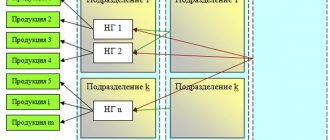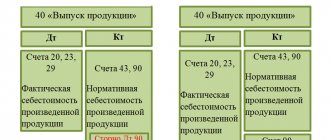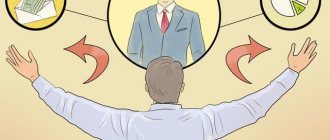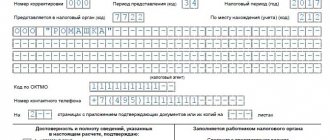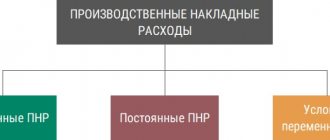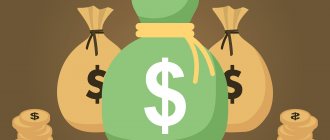Any accountant knows that submitted VAT can be deducted under certain conditions. However, there are cases when, due to legislation or the current situation, this is impossible.
When is it permissible to take into account paid VAT as part of expenses that reduce the income tax base?
What does the Tax Code say about this?
How do tax authorities interpret its provisions, and is their point of view always supported by judicial practice?
All this will be discussed in this article.
What VAT can be included in the price of goods
Current legislation provides for very specific transactions when the VAT charged to the taxpayer can be included in the cost of goods, reducing the base for calculating income tax. This is stated in Article 170 of the Tax Code. According to paragraph 2 of this article, tax can be attributed to the costs of production and sale of goods (work, services) in the following cases:
- if they are used to carry out VAT-free transactions - Article 149 of the Tax Code;
- if products manufactured using them will be sold outside the territory of Russia - Article 148 of the Tax Code;
- if the person purchasing them is not a VAT payer or is exempt from paying this tax;
- if they were acquired for those operations that are not subject to VAT (for example, gratuitous transfer of structures to government agencies and other operations listed in paragraph) - Article 2, Article 146 of the Tax Code of the Russian Federation.
This is an exhaustive list of transactions for which input VAT can be attributed to the cost of goods, work or services, thereby reducing the income tax base.
It is worth noting that not only tax amounts presented directly upon purchase can be attributed to expenses, but also those recovered in accordance with paragraph 3 of Article 170 of the Tax Code of the Russian Federation.
In other words, if goods begin to be used to carry out the operations listed above, then the VAT previously deducted on them should be restored and taken into account as part of other expenses in accordance with Article 264 of the Tax Code of the Russian Federation.
Does the taxpayer have the right to choose?
It is important to keep in mind that the provisions of the law on tax deductions and the procedure for their application (Articles 171 and 172 of the Tax Code of the Russian Federation) are imperative in nature, that is, mandatory. This means that a buyer to whom a supplier has charged VAT does not have the right to choose whether to include the tax amount as an expense or to claim it as a deduction.
Thus, if the taxpayer had grounds for deducting VAT, but for some reason he did not use it, then he does not have the right to include the amount of tax in expenses.
Unrealized right to deduct VAT: special cases
A situation where a company has not exercised its right to deduct VAT can arise for various reasons. The most common of them are the following:
- lack of invoices issued by the seller;
- missing the deadline to claim a deduction.
The first situation often arises when making a purchase in a retail chain. Most often these are some “little things”, for example, stationery for office needs or refueling a car. In this case, it is unlikely that you will be able to obtain an invoice from the seller, and in the opinion of the tax service, it is unlawful to claim VAT deduction based on a cash receipt. The absence of an invoice will be identified immediately when the company's VAT return is processed by the tax office's automated system.
It turns out that it is impossible to deduct the amount of VAT on purchased assets, but at the same time, as mentioned above, it cannot be attributed to expenses that reduce the income tax base. However, those companies and entrepreneurs who want to fight for the deduction of the tax amount in this situation in court have every reason to do so.
The Resolution of the Presidium of the Supreme Arbitration Court No. 17718/07 dated May 13, 2008 determined that under such circumstances it is unlawful to refuse a taxpayer a VAT deduction. This is true provided that there is a cash receipt confirming the purchase, and also the fact that the taxpayer used the purchased goods outside the scope of taxable activity has not been proven.
Nevertheless, the official position of the Federal Tax Service has not changed: VAT can be deducted only on the basis of an invoice , and issues of presenting other primary documents as justification for the deduction are resolved in court.
Speaking about the second obvious reason why a taxpayer may lose the right to deduct VAT, let us turn to paragraph 1.1 of Article 172 of the Tax Code of the Russian Federation. Since its entry into force, namely from the beginning of 2015, the procedure for applying for VAT deduction within three years from the date of registration of goods has been legislated. However, this deadline may also be missed, for example, by mistake or due to lengthy preparation of documents. Be that as it may, it is unlawful to claim VAT deduction outside this period. That is, in this case, the tax will have to be paid, but it will not be possible to attribute its amount to income tax expenses.
As an illustration, let us cite the situation of a Russian exporting company that took too long to collect a package of documents to confirm the zero VAT rate. As a result, she declared “input” tax on transactions taxed at 0% beyond the three-year period, and on this basis was denied a deduction. The amount of tax that the company had to pay was included in income tax expenses, however, the Supreme Arbitration Court did not agree with this position (determination of the Supreme Arbitration Court of the Russian Federation No. 305-KG15-1055 dated March 24, 2015).
An example of a situation where VAT can be attributed to expenses
Another special case is also related to the non-confirmation of the zero VAT rate, but this is not about the tax presented by the taxpayer, but about the cost of his services calculated “on top of” the cost of his services. The situation was discussed in the letter of the Ministry of Finance No. 03-03-06/1/42961 dated July 27, 2015. The department is of the opinion that if the legality of applying the zero VAT rate cannot be confirmed, then the amount of calculated tax at a rate of 18 or 10% on the basis of subparagraph 1 of paragraph 1 of Article 264 of the Tax Code of the Russian Federation should be taken into account as expenses.
In making this conclusion, the Ministry of Finance refers to the resolution of the Supreme Arbitration Court of the Russian Federation dated April 9, 2013 No. 15047/12, issued in a dispute between a large Russian air carrier and the Federal Tax Service. The company failed to collect documents to confirm zero VAT, calculated it at a rate of 18%, paid and included this amount as expenses that reduce profits. The tax service saw this as a violation. However, the Supreme Arbitration Court did not agree with this position and explained that the dispute concerns VAT calculated “from above.” In this case, the rules of tax legislation regarding the accounting of these amounts as expenses should be applied. The court also indicated that this VAT should be expensed immediately after the expiration of the 180-day period provided for submitting documents confirming the zero rate.
Costing of components
After calculating the costs of raw materials and ingredients, we move on to calculating components. The basis of the calculation is the specification provided by the chief technologist or production manager.
For your information
A specification is a list of components used in the production of a finished product.
The calculation of components and their costs/losses for the example under consideration is presented in table. 3.
Table 3
Costing of components and materials for the production of non-alcoholic, highly carbonated drink “Tarragon”
| Accessories | Unit | Quantity | price, rub. (without VAT) | The cost of complete set is 1 bottle. finished product with a capacity of 0.5 liters, rub. (without VAT) |
| Transparent bottle B-500-2v glass | PC. | 1 | 4,24 | 4,24 |
| Aluminum cap d = 38 | PC. | 1 | 0,85 | 0,85 |
| Label facade "Tarragon" 0.5 l | PC. | 1 | 1,27 | 1,27 |
| Counter label “Tarragon” 0.5 l | PC. | 1 | 0,85 | 0,85 |
| Collierette “Tarragon” 0.5 l | PC. | 1 | 0,42 | 0,42 |
| GOST corrugated box (includes 20 pcs.) | PC. | 1/20 | 12,71 | 0,64 |
| Pallet (for 1000 bottles, 50 boxes) | PC. | 1/1000 | 233,05 | 0,28 |
| Total components and materials | spending standard | X | X | 8,55 |
| Spending, bottle | 1,70 % | — | — | 0,07 |
| Spending, cap | 5,60 % | — | — | 0,05 |
| Spending, label | 1,70 % | — | — | 0,04 |
| Waste, corrugated box | 0,50 % | — | — | 0,00 |
| Total expenses | X | X | X | 0,17 |
The principles of calculation are the same as when calculating raw materials and ingredients: we use prices without VAT, take industry expenses or internal expenses of the enterprise. It is important not to miss the distribution of total costs - these are, as a rule, group packaging, pallets and other group materials. The total cost of the package including expenses is 8.72 rubles. without VAT.
VAT included in bad debts
Another case when VAT is included in expenses is if it is part of accounts receivable that are overdue and must be written off . This situation may arise as a result of an unpaid delivery or the transfer of an advance payment for which the goods were never shipped.
After three years, the debt becomes uncollectible and is written off as an expense.
In this case, the company has the right to write off the amount of receivables along with VAT. This procedure does not contradict the official point of view of the Ministry of Finance, as reflected in letter No. 3-07-05/13622 dated March 13, 2015.
It is worth paying attention to one nuance that arises when writing off bad receivables for prepayment. If the VAT presented upon its transfer was previously accepted for deduction, then when the receivables are written off, the tax must be restored. This is the position of the Ministry of Finance, however, many experts consider it controversial, since paragraph 3 of Article 170 of the Tax Code of the Russian Federation does not say anything about the restoration of VAT in this case.
The income tax base reflects not only written-off receivables, but also written-off accounts payable. It arises as a result of non-payment for shipped goods or failure on the part of the company to deliver on account of the advance received when the three-year statute of limitations for these transactions has expired. How to deal with VAT as part of such a “creditor” when writing it off? Let's look at this issue in more detail using specific situations.
If the company’s debt arose due to the fact that goods received were not paid for, then the amount of debt is charged to the income tax account in full, that is, together with VAT. At the same time, tax amounts accepted for deduction upon receipt of goods are not subject to restoration (letter of the Ministry of Finance dated June 21, 2013 No. 03-07-11/23503).
Another case is when accounts payable arose due to the fact that goods were not shipped against the advance received, on which VAT was paid . After the expiration of the limitation period, the amount of debt is included in the income that forms the income tax base. What should I do with the VAT previously paid on this amount? Logically, it should be excluded from income. However, the Ministry of Finance is of the opinion that the Tax Code does not allow reflecting this VAT in expenses (letter of the Ministry of Finance dated December 7, 2012 No. 03-03-06/1/635).
But according to many experts, there is another way out of this situation. They propose to take into account as income tax income not the full amount of the prepayment received, but the amount minus the VAT paid on it. In doing so, they refer to paragraph 2 of Article 248 of the Tax Code of the Russian Federation, which prescribes that the amounts of taxes presented by the taxpayer to the buyer should be excluded from income. However, if the company decides to take this path, it is very likely that it will have to defend its case in court.
We determine the production cost of the manufactured product
Having summed up the costs of raw materials and ingredients, components and materials, expenses and direct production costs, we obtain the production cost of the manufactured product. A summary calculation of the production cost of the non-alcoholic, highly carbonated drink “Tarragon” is presented in table. 5.
Table 5
Summary calculation of the production cost of the non-alcoholic highly carbonated drink “Tarragon”
| Title of articles | Amount of expenses for 1 bottle. finished product with a capacity of 0.5 l, rub. without VAT | Production cost structure, % |
| Granulated sugar | 4,32 | 26,3 |
| Citric acid | 0,17 | 1,0 |
| Flavoring additive "Tarragon" | 2,13 | 13,0 |
| Sodium benzoate | 0,03 | 0,2 |
| Carbon dioxide | 0,07 | 0,4 |
| Water | 0,15 | 0,9 |
| Raw materials and ingredients total | 6,86 | 41,8 |
| Transparent bottle B-500-2v glass | 4,24 | 25,8 |
| Aluminum cap d = 38 | 0,85 | 5,2 |
| Label facade "Tarragon" 0.5 l | 1,27 | 7,7 |
| Counter label “Tarragon” 0.5 l | 0,85 | 5,2 |
| Collierette “Tarragon” 0.5 l | 0,42 | 2,6 |
| GOST corrugated box (includes 20 pcs.) | 0,64 | 3,9 |
| Pallet (for 1000 bottles, 50 boxes) | 0,28 | 1,7 |
| Total components and materials | 8,55 | 52,1 |
| Spending, bottle | 0,07 | 0,4 |
| Spending, cap | 0,05 | 0,3 |
| Spending, label | 0,04 | 0,2 |
| Waste, corrugated box | 0,00 | 0,0 |
| Total expenses | 0,17 | 1,0 |
| TOTAL COST OF RAW MATERIALS AND COMPONENTS | 15,57 | 94,9 |
| Total direct production costs | 0,84 | 5,1 |
| Including: | ||
| wages of primary production workers | 0,42 | 2,6 |
| contributions from the salaries of workers in primary production | 0,13 | 0,8 |
| depreciation of production line/equipment | 0,19 | 1,2 |
| electricity | 0,10 | 0,6 |
| TOTAL PRODUCTION COST | 16,41 | 100,0 |
The production cost of the non-alcoholic, highly carbonated drink “Tarragon” is 16.41 rubles. without VAT. The main share in the production cost of production is occupied by granulated sugar, a bottle and the Tarragon flavoring additive - 26.3%, 25.8% and 13.0%, respectively.
Note!
Analysis of the cost structure allows, among other things, to find ways to reduce the cost of production, which, in turn, is one of the most important tasks of financial and economic services.
For example, some manufacturers of soft drinks replace granulated sugar with sweeteners in order to reduce costs. As a result, the cost compared to our case may decrease by almost 4 rubles. (from 4.32 rubles to 0.25–0.5 rubles).
Accounting for “foreign VAT”
Companies working with counterparties from neighboring countries often have questions about how to deal with VAT, which appears in the primary documents received from them. It is important to understand the following: despite the fact that this tax is called the same as Russian, it has nothing to do with our VAT. This is a tax of a foreign country; it is calculated and paid according to the laws of the country where the company’s partner is a resident.
Thus, the tax called VAT, which appears in the invoices of a foreign counterparty, is not deductible under any circumstances.
How should the “foreign VAT” that is presented to the buyer be reflected in accounting? The point is that it does not need to be taken into account separately. It forms the cost of purchased goods (works, services) and is included in income tax expenses.
In other words, for a Russian company it makes no difference which taxes are included in the cost of goods purchased from a foreign supplier, because the costs will take into account the full amount of the contract.
On the other hand, “foreign VAT” appears in a situation where, when paying for services rendered, a foreign partner, who is a tax agent, withholds this tax from the contract amount. For example, a Russian company provided services to a foreign enterprise, the cost of which was 1,200 conventional units (cu). However, the domestic company received 1000 USD The partner withheld the remaining amount in accordance with the laws of his country as a tax agent.
How should this transaction be reported in income? The Ministry of Finance believes that in full, including withheld foreign tax. That is, in our example, the Russian company must record income from the operation in the amount of CU 1,200. But the amount of tax withheld is 200 USD. can be attributed to expenses taken into account for calculating income tax. (letter of the Ministry of Finance dated May 18, 2015 No. 03-07-08/28428).
True, 21 of the Tax Code does not indicate on the basis of which document the withheld tax can be accepted as an expense. Therefore, in this matter one should be guided by the norms of Chapter 25 , and specifically Article 313 of the Code. It defines the documents on the basis of which income tax withheld by a tax agent can be offset against the tax payable by the taxpayer. Thus, if a foreign partner has withheld s as a tax agent, you should require a document from him confirming this process. If the latter is compiled in a foreign language, it will need to be translated into Russian.
Where to include VAT when re-importing?
Goods that the exporter for some reason is forced to import back into the country are placed under the customs procedure of re-import. In practice, customs authorities generally charge VAT on the value of such goods. The legality of this can be debated, but taxpayers usually prefer to pay the tax in order to get their own goods back as soon as possible. And here the question arises: what to do next with the amount of this tax?
Let us immediately note that VAT paid during re-import cannot be deducted. Paragraph 2 of Article 171 of the Tax Code of the Russian Federation lists all cases when customs VAT can be deducted, and operations for the re-import of goods do not appear there. Based on Article 170 of the Tax Code of the Russian Federation, the amount of tax also cannot be included in the cost of imported goods. After all, most likely, they will be sold in the future, that is, used in activities subject to VAT.
According to experts, it is advisable to attribute VAT withheld when re-importing goods to other expenses that reduce taxable profit, as a tax paid in accordance with the law.
And although paragraph 19 of Article 270 directly prohibits the inclusion of VAT in expenses, it refers to the tax presented by the taxpayer. When re-importing, the owner of the goods does not present the withheld VAT to anyone, therefore, the specified legal norm is not applicable to this situation. This is confirmed by judicial practice. Thus, customs VAT withheld during re-import can be included in other expenses taken into account when calculating the income tax base.
Analyzing the recipe
Depending on the organizational structure of the enterprise/production, the recipe can be obtained from the chief technologist, the head of the enterprise laboratory, or the quality director.
A recipe is the composition of a product in terms of raw materials and ingredients, indicating the consumption rate for a certain volume of products.
In non-alcoholic production, the consumption of raw materials and ingredients is indicated per 100 dl of finished product, in alcohol production - per 1000 dl of finished product, in meat production - per 1 ton of finished product, etc.
Table 1 shows the recipe for the non-alcoholic, highly carbonated drink “Tarragon”.
Table 1
Recipe for non-alcoholic, highly carbonated drink “Tarragon” (per 100 dl of finished product)
| Raw materials, ingredients | Unit | Quantity, in units.meas. |
| Granulated sugar | kg | 200,00 |
| Citric acid | kg | 5,00 |
| Flavoring additive "Tarragon" | kg | 5,00 |
| Sodium benzoate | kg | 0,50 |
| Carbon dioxide | kg | 5,00 |
| Water | gave | 100,00 |
Note!
The recipe, as a rule, does not indicate the loss of raw materials and ingredients during production. At the enterprise, they are approved on the basis of industry loss standards, taking into account the specifics and production technology.
After the economic department has received a signed and approved recipe, you can begin to calculate raw materials and ingredients.
